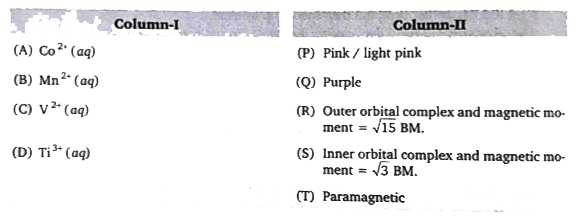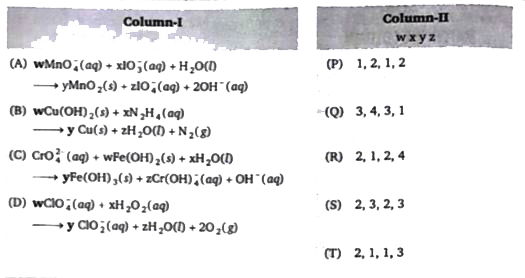Match the entries of column I with appropriate entries of coloumn II. Each entry in column I may have one or more than one correct option from column II. If the correct matches are A-p, s , B-r, C-p, q , D-s, then the correctly bubbled 4 × 4 matrix should be as follows :
Column IColumn II(A)H3PO3Δ−−→(p)One of the products acts as a reducing agent.(B)PCl3+H2OΔ−−→(q)One of the products is a tribasic non-reducing acid.(C)NO2+H2O→(r)Dehydration(D)HNO3+P4O10Δ−−→(s)In one of the products, central atom has +5 oxidation state.
The correct Answer is:A-p, q, s ; B-p ; C-p, s ; D-r, s
To solve the matching problem between Column I and Column II, we will analyze each entry in Column I and determine which entries in Column II correspond to it based on the chemical reactions and properties described.
1. Analyze Entry A: H₃PO₃ (Phosphorous acid) heated
- When H₃PO₃ is heated, it decomposes to form H₃PO₄ (Phosphoric acid) and PH₃ (Phosphine).
- PH₃ acts as a reducing agent because it can donate electrons.
- H₃PO₄ is a tribasic acid (it can donate three protons) and is non-reducing.
- Therefore, A matches with:
- P: "One of the products acts as a reducing agent." (PH₃)
- Q: "One of the products is a tribasic non-reducing acid." (H₃PO₄)
- R: "Dehydration" (H₃PO₃ can undergo dehydration to form H₄P₂O₇)
2. Analyze Entry B: PCl₃ + H₂O heated
- PCl₃ reacts with water to form H₃PO₃ and HCl.
- H₃PO₃ has a +3 oxidation state for phosphorus, and it can act as a reducing agent.
- H₃PO₃ is not a tribasic acid; it is a dibasic acid (it can donate two protons).
- Therefore, B matches with:
- P: "One of the products acts as a reducing agent." (H₃PO₃)
- R: "Dehydration" (H₃PO₃ can lose water to form HPO₂)
3. Analyze Entry C: NO₂ + H₂O
- NO₂ reacts with water to form HNO₃ (Nitric acid) and NO (Nitric oxide).
- NO acts as a reducing agent because it can be oxidized to NO₂.
- HNO₃ is a monobasic acid (it can donate one proton).
- Therefore, C matches with:
- P: "One of the products acts as a reducing agent." (NO)
- R: "Dehydration" (HNO₃ can undergo dehydration)
- S: "In one of the products, central atom has +5 oxidation state." (HNO₃ has nitrogen in +5 state)
4. Analyze Entry D: HNO₃ + P₄O₁₀ heated
- HNO₃ reacts with P₄O₁₀ to form HPO₃ and N₂O₅.
- Both HPO₃ and N₂O₅ have phosphorus and nitrogen in the +5 oxidation state.
- HPO₃ can undergo dehydration.
- Therefore, D matches with:
- R: "Dehydration" (HPO₃ can lose water)
- S: "In one of the products, central atom has +5 oxidation state." (both HPO₃ and N₂O₅)
Final Matches:
- A: P, Q, R
- B: P, R
- C: P, R, S
- D: R, S
Summary of Matches:
- A → P, Q, R
- B → P, R
- C → P, R, S
- D → R, S
- When H₃PO₃ is heated, it decomposes to form H₃PO₄ (Phosphoric acid) and PH₃ (Phosphine).
- PH₃ acts as a reducing agent because it can donate electrons.
- H₃PO₄ is a tribasic acid (it can donate three protons) and is non-reducing.
- Therefore, A matches with:
- P: "One of the products acts as a reducing agent." (PH₃)
- Q: "One of the products is a tribasic non-reducing acid." (H₃PO₄)
- R: "Dehydration" (H₃PO₃ can undergo dehydration to form H₄P₂O₇)
2. Analyze Entry B: PCl₃ + H₂O heated
- PCl₃ reacts with water to form H₃PO₃ and HCl.
- H₃PO₃ has a +3 oxidation state for phosphorus, and it can act as a reducing agent.
- H₃PO₃ is not a tribasic acid; it is a dibasic acid (it can donate two protons).
- Therefore, B matches with:
- P: "One of the products acts as a reducing agent." (H₃PO₃)
- R: "Dehydration" (H₃PO₃ can lose water to form HPO₂)
- NO₂ reacts with water to form HNO₃ (Nitric acid) and NO (Nitric oxide).
- NO acts as a reducing agent because it can be oxidized to NO₂.
- HNO₃ is a monobasic acid (it can donate one proton).
- Therefore, C matches with:
- P: "One of the products acts as a reducing agent." (NO)
- R: "Dehydration" (HNO₃ can undergo dehydration)
- S: "In one of the products, central atom has +5 oxidation state." (HNO₃ has nitrogen in +5 state)
- HNO₃ reacts with P₄O₁₀ to form HPO₃ and N₂O₅.
- Both HPO₃ and N₂O₅ have phosphorus and nitrogen in the +5 oxidation state.
- HPO₃ can undergo dehydration.
- Therefore, D matches with:
- R: "Dehydration" (HPO₃ can lose water)
- S: "In one of the products, central atom has +5 oxidation state." (both HPO₃ and N₂O₅)
- A: P, Q, R
- B: P, R
- C: P, R, S
- D: R, S
- A → P, Q, R
- B → P, R
- C → P, R, S
- D → R, S
Topper's Solved these Questions
- BOOK - PRADEEPCHAPTER - P-BLOCK ELEMENTS EXERCISE - INTEGER TYPE QUESTIONS15videos
P-BLOCK ELEMENTS
- BOOK - PRADEEPCHAPTER - P-BLOCK ELEMENTS EXERCISE - ASSERTION-REASON TYPE QUESTIONS30videos
P-BLOCK ELEMENTS
- BOOK - PRADEEPCHAPTER - P-BLOCK ELEMENTS EXERCISE - MCQ164videos
P-BLOCK ELEMENTS
- BOOK - PRADEEPCHAPTER - ORGANIC COMPOUNDS CONTAINING NITROGENEXERCISE - IMPORTANT QUESTIONS FOR BOARD EXAMINATION27videos
ORGANIC COMPOUNDS CONTAINING NITROGEN
- BOOK - PRADEEPCHAPTER - POLYMERSEXERCISE - IMPORTANT Questions (For Board Examination)27videos
POLYMERS
Similar Questions
Match the entries of column I with appropriate entries of coloumn II. Each entry in column I may have one or more than one correct option from column II. If the correct matches are A-p, s , B-r, C-p, q , D-s, then the correctly bubbled 4 × 4 matrix should be as follows :
Column IColumn II(A)SO2(p)Basic(B)H2SO4(q)Acidic(C)HNO3(r)Reducing(D)NH3(s)OxidisingView SolutionMatch the enteries of column I with appropriate entries of column II Each entry in column I may have one or more than one correct option from column II .
Column I Column II (A)Magnesium (p)p−Block (B)Aluminium (q) Metal (c)Arsenic (r) s- Block (D)Iodine (s) MetalloidView SolutionMatch the enteries of column I with appropriate entries of column II Each entry in column I may have one or more than one correct option from column II .
Column I Column II (A)C1 ,Br, I(p)Ionization enthalpy increases (B)B,C,O (q)Negative elecron gain enthalpy decreases (C)O2−,O−,O−, O(r) Atomic size decreases (D)C1 ,F ,P(s)Belong to the same groupView SolutionEntries of Column-I are to be matched with entries of Coloumn-II. Each entry of Column-I may have the matching with one or more than one entries of Column-II.
 View Solution
View SolutionEntries of Column-I are to be matched with entries of Coloumn-II. Each entry of Column-I may have the matching with one or more than one entries of Column-II.
 View Solution
View SolutionEntries of Column-I are to be matched with entries of Coloumn-II. Each entry of Column-I may have the matching with one or more than one entries of Column-II.
 View Solution
View SolutionEntries of Column-I are to be matched with entrices of Column-II. Each entry of Column-I may have the matching with one or more than entries of Column-II
 View Solution
View SolutionEntries of Column-I are to be matched with entrices of Column-II. Each entry of Column-I may have the matching with one or more than entries of Column-II
 View Solution
View SolutionEntries of Column-I are to be matched with entrices of Column-II. Each entry of Column-I may have the matching with one or more than entries of Column-II
 View Solution
View SolutionEntries of Column-I are to be matched with entrices of Column-II. Each entry of Column-I may have the matching with one or more than entries of Column-II
 View Solution
View Solution

